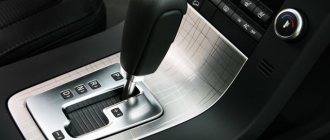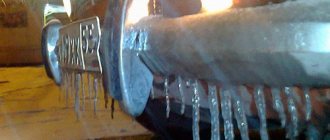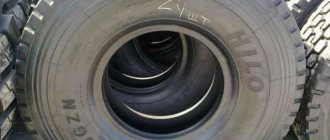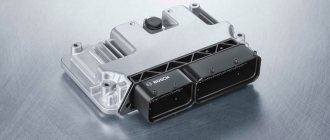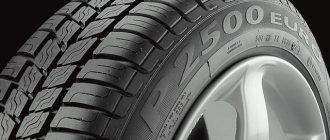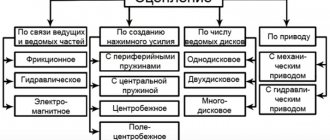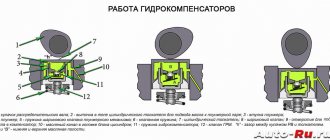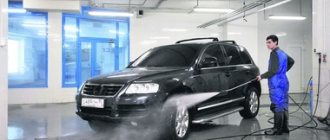Many drivers prefer to drive in high gears to save gas. And the reduced ones are turned on only in cases where the engine power is no longer sufficient for movement. But this, as a rule, does not give the expected effect, so you need to learn how to engage a lower gear in advance.
A lower gear is necessary in cases where a large load is placed on the engine, for example, when driving uphill, overtaking, sharp turns, etc. But the gear change itself and, more importantly, the power gain is far from instantaneous. As a result, the habit of saving fuel and downshifting when the engine is almost starting to “sneeze” turns against drivers. Let's look at this using the example of overtaking and entering the lane with oncoming traffic.
This maneuver almost always begins with the overtaking car moving strictly behind the overtaken vehicle for some time or, as they say, “hanging on the bumper.” At the same time, their speeds are equal, and the forces exerted by the engines of both cars are also similar. When entering the oncoming lane to start overtaking, the car moves at the same speed, but now it needs to accelerate sharply. If you don't downshift early, it's almost impossible to do so. At the very least, this takes time, but different vehicles are also moving towards you.
So it turns out that if you don’t engage a lower gear when overtaking, you must either return to your lane or frantically maneuver in the oncoming lane, trying to pick up speed and avoid getting into an accident. At the same time, being behind the car you are overtaking and turning on a reduced speed, you begin to accelerate at the moment of taxiing into the oncoming lane and calmly pick up the required speed. Thus, performing the maneuver clearly, quickly and accurately.
It is also advisable to engage a lower gear when passing almost any corner. This method has two advantages. First, the front wheels become more loaded, and therefore more stable, which makes maneuvering easier. Secondly, you can emergency brake with the engine if necessary, or, conversely, accelerate and go around a sudden obstacle without losing time.
The widespread use of fuel economy has led to the fact that most drivers are accustomed to driving in higher gears, and switching to lower gears only when the engine is almost ready to stall. This type of driving can lead to very sad consequences in many situations. The main problem is that by constantly using higher gears, the driver develops a certain skill in driving a car, which works almost instinctively, including in critical situations. And often it is the presence of such a skill that can make a completely harmless (if the car is driven correctly) situation critical.
The firmly ingrained skill of shifting to a lower gear only with an almost complete loss of engine power leads to a critical situation when driving uphill, when overtaking while entering the reverse lane, during an emergency detour around an obstacle, on a sharp turn, etc.
Consider, for example, the situation with overtaking when entering oncoming traffic. Most often, before you start overtaking, you have to “hang on the bumper” of the car in front, and the speeds of the cars are equal. An inexperienced driver, who has the bad habit of switching to lower gears only when engine power is lost, will “hang on the bumper” without changing gears until the moment of overtaking, and then, still in the same high gear, will jump into the oncoming lane, where he will find that it is impossible to increase the speed - the engine “does not pull”, there is not enough power. And it’s good if he has the opportunity to calmly change gears, increase speed and complete the overtaking and return to his lane. It often happens that you have to return to your lane without overtaking, and again “hang on the bumper”, and still on the same one. But you may not be so lucky that an accident occurs with very serious consequences, because such a trip into the oncoming lane can result in the most serious thing - a head-on collision.
But if, before entering the oncoming lane, you switch the gear to a lower one and start overtaking with the throttle on, then the car picks up speed much faster and the maneuver itself is carried out and completed quickly, while the time spent in the oncoming lane is minimal.
Negotiating a turn in a downshift is considered safer than in an upshift (with torsion). The fact is that when downshifting, you can use the braking effect of the engine, which loads the front wheels and allows you to counteract the centrifugal force. In addition, this allows you to dose braking when turning without locking the wheels, and also provides a reserve of power and acceleration in order to overcome a critical situation if it arises.
Most often, maintaining the required engine power is associated precisely with advanced switching to a lower gear, and not at all with switching at the moment when a loss of power has already occurred. The fact is that during the switching itself, from 300 to 2000 rpm is lost, so if power is already lost, then during switching the losses will be even greater. This often happens, for example, when driving uphill: the ascent begins at a speed of 60 km/h in fifth gear, but literally immediately the driver discovers that the engine “does not pull.” He diligently “sinks” the gas pedal to the floor, and the speed continues to drop, then switches to fourth gear and... the engine again “does not pull”! But the whole point is that the switching was late; during the switching, additional power losses occurred and a third, or even a second gear (depending on the steepness of the climb) is required to restore engine power. But if, before starting the climb, you switch to a lower gear, the same fourth, and perform advanced throttling, then there will be no problems, the car will overcome the climb completely calmly and easily.
There is a trick that allows you to restore engine power on an incline without going into very low gears (in the above situation, using this technique, shifting to fourth gear would be sufficient). This technique is a re-throttle, which is performed with the clutch depressed and maximum fuel supply. This technique is performed as follows. If, when driving in a higher gear on an ascent, the car does not respond with acceleration to the force applied to the gas pedal, then you should continue the effort (gas pedal to the floor) and slowly depress the clutch pedal - this will cause a sharp increase in the engine crankshaft speed. This is where the downshift is engaged, but the clutch pedal is still held depressed, and only when the maximum crankshaft speed is reached can the clutch pedal be smoothly released. The goal will be achieved - engine power will be restored and the car will move with acceleration.
NOTE
The over-throttle technique with the clutch depressed and maximum fuel supply will only work when it is applied ahead of time, that is, until the engine power is completely lost.
You need to be aware that not in all situations there is enough time to shift from upshift to downshift in the standard sequence, one after the other.
In a critical situation, sometimes you have to switch to lower gears, skipping the sequence (for example, from fifth to third, from fourth to second). This switching is usually done to perform an emergency maneuver in order to create a reserve of engine power.
It is better to perform shifting with skipping the sequence in the same way as the maneuver described above for climbs, that is, with re-throwing and holding the clutch. Re-throttle allows you to avoid blocking the drive wheels when the clutch is engaged, and the clutch delay softens the dynamic impact.
This method of switching to lower gears is used when the car is moved to the reverse lane or thrown onto the side of the road. Overcoming the centrifugal force is carried out using engine power, but the car must be turned with its front part towards the inside of the turn.
Shifting gears with skipping the sequence is also used to create torque (sliding of the rear axle of the car) in order to put the car into a controlled skid (to prevent rollover) (Fig. 84).
Rice. 84.
If the car is front-wheel drive, such a downshift can be dangerous if you do not control engine traction - wheel slip can cause them to drift and the car to be taken off the trajectory. But on a road with a low coefficient of wheel adhesion to the road surface, slipping (if you know how to use it) helps stop skidding and helps stabilize the car.
In normal driving, downshifting with skip sequences is used to accelerate after prolonged braking in direct gear, before a difficult section of broken road, to accelerate after a sharp turn, before a steep ascent or descent on a dirt road.
Also, this technique in some conditions can be used as a “brake”, as mentioned earlier.
If the coefficient of adhesion between the wheels and the road surface is low (slippery road), then switching to lower gears allows you to maintain vehicle stability. As you know, on such a road sudden actions are contraindicated; they instantly cause a critical skid, rhythmic skidding or uncontrolled rotation. Not very experienced drivers provoke such situations by braking using the service brake system, which first leads to uncontrolled lateral or longitudinal sliding, and only then follows a critical skid and uncontrolled rotation.
Switching to lower gears allows you to avoid all these problems: either by accelerating or by engine braking (without locking the wheels) the stability of the car is regulated and controlled; Increasing traction on the drive wheels allows you to adjust the skid angle (rear-wheel drive car) and the drift angle of the front axle (front-wheel drive car). In addition, a reserve of power is created, which allows you to overcome critical situations when spinning or throwing the car to the side of the road.
However, there is a small problem: when the car is about to lose control, changing gears can lead to loss of stability. And at the same time, if the gear is not changed, it is impossible to definitely cope with a critical situation - a vicious circle! To cope with this “insoluble” problem, it is enough to perform a sequence of actions that allow you to maintain vehicle stability when switching to a lower gear (Fig. 85):
- the right hand moves to the gearshift lever, the left hand continues to manipulate the steering wheel to stabilize the car. At the same time, gas supply continues (it is impossible to completely stop gas supply, at least minimally, but it is necessary to maintain the fuel supply);
- The clutch pedal is gently and smoothly depressed, and at the same time the downshift is engaged with a delay (that is, not by jerking into the desired gear, but through the “neutral” passage, and only then into the lower gear). During the delay, a re-throttle is performed, which allows the engine speed to be increased (accelerating or braking impulses on the drive wheels are eliminated).
Rice. 85.
The delay when engaging the clutch allows you to compensate for errors in the accuracy of the throttle shift.
Which gear to choose and what is the correct shifting algorithm is a seemingly trivial question, but only for those who are used to driving a manual transmission and have been doing this for quite a long time. The note is intended for those who intuitively have switching skills. To gain basic knowledge, I recommend that you first read the note.
How to switch gears in general?
Let us first analyze the simplest case, when we are accelerating, and we will accelerate without braking to the required speed. Looks like we've set off and are sorting through the gears. But it's not that simple. So we started off in first gear... Read about it, just in case. As soon as the clutch pedal is released completely, we begin to gradually add gas so that the speed begins to increase more or less rapidly. And now the speed reaches... And here are the possible options. You can spin the engine up to 3000, 4000, 5000, 6000 rpm, or you can even switch to 2000 and even lower. It all depends on the required acceleration dynamics.
If your goal is to win a quarter-mile race, then of course you need to put the engine in maximum power mode and keep it in that mode for the entire track. Here it is important to know the characteristics of your car. If maximum torque is achieved at 4000 rpm, then after shifting to the next gear the rpm value should not be lower than the maximum torque number.
Thus, with a maximum torque of 4000 rpm, it is necessary to spin the engine to at least 5000-5500 so that after switching the engine continues to accelerate briskly. But we’re not on a track, and we won’t do quarter-mile races... Of course, yes. Be careful with overclocking. It's better to under-accelerate than over-accelerate. However, the example is very illustrative. The higher the speed, the more dynamic the acceleration. Therefore, at what speed to switch is up to you, and only depending on the situation.
Demultiplier
The multiplier is structurally included in the transfer case circuit or is designed as a separate unit. In automatic transmissions, the transfer case may not be present, and its functions are performed by some parts and components in the gearbox. An additional gearbox, which has a reduction gear (multiplier), is designed to increase traction forces on the wheels. The multiplier is a transmission mechanism that is designed to increase torque. It is installed, as a rule, on those cars that are intended for use in poor road conditions. In this case, the usual number of gears in the box will not be enough; obtaining an intermediate gear ratio in the transmission will help here.
Let's consider this situation: in fourth gear at a certain speed, the engine operates under specific conditions with overload; in lower gear, third, the engine is “overtwisted.” In this case, an additional gearbox will help.
How to operate the clutch when shifting
I won’t go into too much detail. The only thing that can be said is that the clutch, in general, must be depressed quickly and the pedal released smoothly, dosing the traction force of the engine with the wheels, because in the end we either choke the acceleration of the engine with the wheels, or, on the contrary, we spin the engine due to the torsion of the wheels. Therefore, try to avoid bumps (when the engine spins faster than the wheels need) or dives (when the engine spins slower than the wheels need). Why try to avoid? I'll explain now:
- Impacts - they obviously won’t add life to your clutch disc, but that’s not all. On a snowy and especially icy road, wheel slip may occur, which can lead to the front axle drifting for front-wheel drive vehicles and skidding for rear-wheel drive vehicles. All-wheel drive has a lottery. The whole car can float, or it can work out the rule for both rear and front wheel drive.
- Pecks - for rear-wheel drive vehicles, the rear axle may skid (more likely to drift, of course, but I have never seen such a concept), while for front-wheel drive vehicles the same notorious drift of the front axle may begin. With all-wheel drive, it depends, and it depends on the drive.
Which is worse? Yes, both are quite unpleasant, and both phenomena can lead to sad consequences. We have learned how to work with the clutch correctly, but that’s half the battle. Remember, I talked about speed, dynamics, and that when releasing the clutch we definitely throttle or accelerate the engine. This is because it is almost impossible to choose the ideal speed. Well, okay. Not really means we won’t. Wait a minute though. We can help the engine by bringing the speed up to the required speed. When accelerating, the faster we shift, the fewer revolutions we will lose.
Moreover, we can regulate the dynamics of the loss of speed with the gas pedal. What? Were you taught to release the gas pedal when shifting completely? Forget it. It only makes sense to release the throttle completely during very fast shifts. Usually, only part of the gas is released. Let's say you pressed the gas 50%. Before switching, we catch the moment when the car stops accelerating, then release the gas a little more, and switch.
For example, we pressed the gas at 50%, revved the engine, then felt the acceleration stop at 40%, squeezed the clutch, released the gas a little more so that the revolutions began to drop a little, and released the clutch pedal. Letting go, not abandoning. Ideally, the revs should drop to the number that the car would be traveling at in the gear you want to engage. For example, we are going to the second, 3000 rpm, speed 50 km/h. We need to switch to third. In third gear, the car would travel 50 km/h at 2000 rpm, therefore, when shifting, the rpm should be as close to 2000 as possible.
By the time the clutch is released, when the engine is already in some contact with the wheels, you can lightly add gas. This will allow you to avoid pecks, but passengers digest pecks worse than light accelerations. And now homework. Describe the downshift logic. Just kidding, just kidding. Read) Switching to a lower gear is more difficult than switching to a higher gear. That is, it is easier to switch from second to third than from third to second. I'll explain why.
When we switch from second to third, our task is to make the speed lower than it is now. We are driving at 3000, after switching it should be 2000. But when switching to a lower gear it was 3000, it should become 4000. And it is more difficult to accelerate the engine than to stop it. Just remember how easily you stall, and what effort it takes to get going. So, in essence, there are two techniques for engaging a lower gear:
- Increase the engine speed so as not to accelerate it with the wheels
- Release the clutch very smoothly so as not to get a strong dive, because in some cases engine braking (and this is exactly what it is, when we do not touch the gas, and at the same time there is traction between the engine and the wheels) can be very effective.
I'll tell you right away. Do not even think about turning down the engine if there is a risk of going beyond the operating speed of the engine. Let's say you are driving in fifth and your rpm is 5000, and the maximum rpm is 6000. If you switch to 4th, you may still be lucky, but if you switch two gears lower, that is, to third, then the engine may become very bad. Of course, the gearbox is cleverly designed, and is unlikely to allow you to commit such an act of vandalism, however, the gearboxes tore and the engines failed.
But shifting down a few gears is quite normal. Let’s say you were driving down a mountain, and you had fifth gear engaged (well, that’s not correct, because from a mountain it is highly advisable to engage something below direct gear) and then you brake. But you brake correctly and don’t press the clutch. You remember that the transmission should be turned on for as long as possible. If it is not possible to drive in fourth, turn on third; if it is not possible in third, turn on second. Well, you were driving down the mountain in fifth, and then you had to brake sharply, then it turned out that the hare changed his mind about crossing the road, but you already have 1500 rpm and you are rolling up the hill, where your engine cannot get out at such modest speeds.
Of course, you need to turn on at least fourth, or better yet third, in order to quickly pick up the previous speed, because driving along the highway extremely slowly is impossible, and sometimes dangerous (extremely slow is 30-40 km/h). So we increased the revs and, engaging the gear, smoothly released the clutch.
Why is a differential needed?
Most summer residents prefer to purchase country equipment with a differential, and beginners do not quite understand how such a walk-behind tractor differs from a regular one. In more simple and unprofessional language, a locking rotary extension is usually called a differential. The main function performed by the described component of the walk-behind tractor design is to reduce the radius when turning the equipment. Accordingly, it becomes possible to make the wheelbase larger and increase the plowing width. The equipment does not tip over when turning, while it demonstrates amazing maneuverability.
When using the differential, one wheel is locked, that is, the wheels begin to act independently of each other, resulting in a simpler turn (turning on the spot).
This technique is perfect for those who do not want or cannot make additional efforts to change the direction of movement of the walk-behind tractor. Attachments, as well as its absence in the design, do not in any way affect the described ability.
There is another advantage to the differential if you use a locking bolt and move it from the hole in the bushing to the cylindrical recess. In this case, the element can play the role of an extension, which allows you to increase the wheelbase of the vehicle.
The differential is installed on the input shaft, which must be round with a diameter of 30 millimeters.
Which gear to choose and how to shift correctly
Well, a very philosophical question. Let's think about it. We have six driving modes in a specific gear. Actually, now it is possible to systematize the gear selection algorithms (the value of the revolutions immediately before shifting, of course, conditional values, which may be different on your car):
| 1500 rpm | 3000 rpm | 5500 rpm | |
| Acceleration followed by deceleration | Switching to low | We release the gas and slow down with the brake or not | We release the gas, keeping in mind that the engine will slow down the car more than 3000 |
| Acceleration followed by uniform movement | We don't change gears | Switching to high | |
| Uniform movement, which is likely to be followed by braking or stopping | Downshifting | Let's release the gas | We release the gas, but smoothly, as the car may bite |
| Uniform movement followed by acceleration | Downshifting | We don't change gears | Turn on high |
| Deceleration followed by uniform movement | We don't change gears | Turn on high | We switch to two elevated ones |
| Deceleration followed by acceleration | Downshifting | We don't change gears | Switching to high |
If you see an error in the table, write about it in the comments. I’ll say right away that the table is rather approximate, because there are quite a lot of situations, and everything depends solely on your ability to predict and knowledge of your car. I gave only a rough guide.
And finally, I will answer the question of one of the readers: “Please describe the process of changing gears at speed, from low to high, and in what cases vice versa. If you can go into more detail, the order is of course clear: 1st - just to get going... then 2-3-4-5... But there are moments: you’re driving at 4 and there’s a traffic jam or a traffic light, you need to slow down, and then it’s green and traffic starts at a slow speed... is it necessary to switch to 3 or can you continue moving to 4, but slowly... and similar nuances...".
I usually focus on the situation and the flow speed in general. Let's say the cars ahead are accelerating, but it is clear that after 5-6 cars the flow is slowing down again. There is simply no point in accelerating and you can continue driving in the gear you were driving in, or you can turn it down and regulate the speed of the car by accelerating and braking the engine.
In my case, it all depends on my mood, the likelihood that someone will start squeezing in without warning and other factors, but most often I switch to low to keep the engine in good shape all the time, or in other words, in the zone of comfortable and powerful speeds.
Off-road without reduction
SUV with reduction gear KIA Sorento
In recent years, the trend towards increasing the civility of SUVs and crossovers has acquired a scale that is depressing for experienced jeepers. Real SUVs are chasing comfort, which leads to an increase in their prices, and often to a decrease in cross-country ability and closer proximity to crossovers. Crossovers, in turn, are becoming more and more similar to asphalt machines. There are practically no frame SUVs left. Many people part with downshifts. Following the flagships, other SUVs are also becoming lighter. So the KIA Sorento has remained without a downshift since 2009. What can we say then about crossovers! The Porsche Cayenne S with a 6-speed Tiptronic S transmission has a reduction gear, but since 2010 the Porsche 958 Cayenne has received a new version of Tiptronic with 8 steps, but without a reduction gear. The designers of the Audi Q7 also abandoned downshifts. A general trend is visible, the paradox of which illustrates the “spiral” nature of development. Modern crossovers, or rather that part of them that has some claims to the title of SUV, are simply supplemented with 1-2 steps in the gearbox. The transmission of a quite “budget” Renault Duster is designed in such a way that it is better to start on the asphalt in second gear, and leave first for driving on questionable roads. Actually, their designers repeat the line of thought of the LuAZ developers. Only with other tasks. The buyer is inclined to pay more for comfort than for the capabilities of the car. This is probably a real change in the needs of the majority of motorists. And for true connoisseurs of free movement in different directions, there remain the indestructible simple cars of the last century and the off-road supercars of the new century.
All-wheel drive vehicles, unlike single-wheel drive vehicles, are equipped with a unit such as a transfer case or transfer case. Its purpose is to correctly distribute the torque between the axles of the car, and increase it to overcome difficult places (not for all cars). The transfer case is installed after the gearbox or as a separate unit, sometimes as a single unit with the gearbox.
Do you want the car to buck? Turn it down!
With downshifts the situation is somewhat more complicated than with upshifts. If you are a novice driver and this is not obvious to you, do the following: accelerate to 50 km/h in 3rd gear, engage 2nd gear and quickly release the clutch pedal as usual. As a result, the tachometer needle will jump up sharply, and the car will jerk violently. Try it! Happened?
This will always happen when moving from a higher gear to a lower gear, only the intensity of the jerk will be different depending on the speed and gear. Why does the jerk occur? As the sharply “bouncing” tachometer needle shows us, when the gear is lowered, the engine speed increases. If, when switching from II to III gear, the needle drops from 3500 to 2500 rpm, then when switching from III to II, on the contrary, it jumps from 2500 to 3500. This means that by including a lower gear, we forcibly accelerate the engine to higher revs. Since the rotating parts of the engine are heavy and inert, they resist spinning up, which is what results in the machine jerking. It turns out that the jerk is like a protest of the motor
Gear ratio (gear ratio)
When creating a belt drive, we need to understand how much we will gain or lose in speed and strength in order to assemble a device with the desired characteristics.
The gear ratio, which is written as i, will help us with this. It shows how many times the output rotation speed has decreased. According to the golden rule of mechanics, the force will increase by the same amount.
For example, the gear ratio i = 1: 1 shows that 1 revolution at the input will give 1 revolution at the output, and the ratio i = 5: 1 shows that 5 revolutions at the input will give 1 revolution at the output, that is, the speed has dropped by 5 times ( reduction gear).
If a fraction can be reduced, it is reduced. For example, i = 5: 25 = 1: 5 (overdrive).
The gear ratio can be written as a number by dividing the numerator by the denominator. For example, i = 5: 1 = 5, or i = 1: 4 = 0.25. We can conclude that:
The formula for calculating the gear ratio can be derived from the lever rule. The gear ratio for a belt drive is calculated as follows:
You can find out the size of the pulleys using a ruler. The most accurate method for measuring diameter is using a caliper.
Rice. 10. Two ways to measure pulley diameters
If the transmission is multi-stage (two-, three-stage, etc.), then the total gear ratio will be calculated as the product of the individual gear ratios. The gear ratio for pulleys rigidly mounted on a common axis is not considered - their rotation speed will always be the same!
This formula is valid for this drawing:
Rice. 11. Multi-stage belt drive
In the same way, the gear ratio can be calculated using radius ratios.
Over-gas or clutch?
So I recommend that you regularly, every time you downshift, use the throttle and, preferably, double depressing the clutch pedal. By throttling, you will change gear faster, smoother and safer for both road traffic and vehicle parts than by smoothly releasing the clutch pedal. Of course, it’s difficult to master re-gasping, but if you do it, I’m afraid you’ll like it so much that you won’t be able to tear it away! And then you won’t be jailed for a machine gun :)))
Why does a walk-behind tractor need a differential?
A walk-behind tractor with a differential quite often becomes the object of hunting for a modern summer resident. Differentials are also called locking rotary extensions, which are necessary to reduce the turning radius, this allows you to increase the wheelbase, or more precisely, the width of the track and wheels. Thus, the walk-behind tractor becomes more maneuverable and tipping over when turning is excluded.
The differential is capable of blocking one wheel, as a result it is possible to achieve independent movement of the wheels, guaranteeing easy turning. A walk-behind tractor with a differential can be deployed without the use of physical effort, and this ability will not be affected by the presence or absence of attachments. If you move the fixing bolt from the bushing groove into the cylindrical hole, then the differential can be used as a simple extension, which is necessary to increase the wheelbase.
Differentials are installed on equipment output shafts and are suitable for units with round output shafts with a diameter of 30 mm. Now that it has become clear what a walk-behind tractor with a differential is, we can consider some of the most popular models, their features and characteristics will be discussed below. After reading the reviews, you can make your choice.
Reviews about the main features of the CROSSER CR-M8E walk-behind tractor
This model, according to buyers, is quite expensive - the price is 80,300 rubles, but the cost is justified, because the equipment is a professional unit. It is used to cultivate soil up to 3 hectares. Buyers note that one of the advantages is that the equipment is equipped with a single-cylinder four-stroke engine, the power of which is quite impressive and amounts to 5.2 kW.
The front power take-off shaft allows you to connect all kinds of attachments such as mowers. There is a differential lock. The diesel engine is equipped with an electric starter, and the gear reducer significantly increases the service life of the equipment. Buyers emphasize that the walk-behind tractor with a differential of this model is supplied disassembled, which is very convenient for transportation over long distances. However, you can take advantage of the option of assembling the unit.
